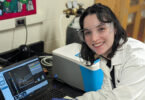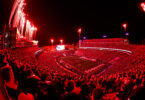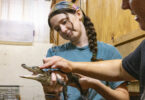The Lamar Dodd School of Art Galleries present Inner Space, an exhibition documenting the collaborative efforts of professors at UGA’s Lamar Dodd School of Art, the department of physics and astronomy and the Faculty of Engineering.
On display until May 9 in the main gallery in the Visual Arts Building, the exhibition is a collaboration between Michael Oliveri, associate professor of art; Zhengwei Pan, an assistant professor with the Faculty of Engineering and the physics and astronomy department; Zhanjun Gu, a post-doctoral researcher; and Feng Liu, a post-doctoral researcher.
Inner Space offers our everyday world re-visited, the atomic or molecular scale blown up and made relevant to the naked eye.
Nanotechnology is used in commercial applications such as suntan lotion, cosmetics, protective coatings, drug delivery and stain resistant clothing, all of which mainly use the advantages of nanostructures. In the course of developing and building nanoscale structures for such applications, scientists and engineers like Pan record micrographic images to verify the sizes and shapes of certain structures, to quantify their properties. One of the few instruments which can record these types of images is an electron microscope. For Inner Space, zinc oxide, silicone oxide nanoscale structures are some of the materials under investigation, and being considered for optical and opto-electrical applications as diverse as high output LED lighting.
The decisions made and insights revealed in this process happen at a scale that is 1/10,000 the width of a human hair.
While normally only visible with the scientist’s high powered imaging technology, Oliveri uses this technology to travel through the nano samples much as any photographer looking through a lens travels through landscapes in the macro world. He found situations that touch on the sublime, areas which seem to be familiar but at a closer look are completely new in every way to the visual eye. Shooting a series of continuous images and stitching them together his micrograph landscapes give you a sense of what this inner space is like.
In Inner Space, the laboratory and the studio are synonymous worlds: both are vehicles for investigation, where theories and hypotheses are tested, and hand and mind come together.







